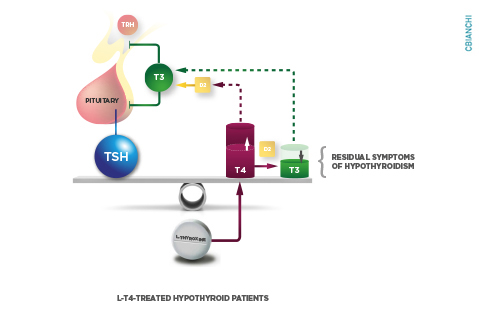Hypothyroidism affects more than 10 million Americans, mostly women, and hundreds of millions worldwide. For 90 years since the first cases were described, hypothyroid patients were treated with capsules containing desiccated animal thyroid. With the discovery in the 1970s that deiodinases convert T4 to T3 in humans and the development of a method to measure TSH levels in the blood, L-thyroxine monotherapy at doses that normalize TSH levels became the standard of care. This approach is efficient for most hypothyroid patients. Unfortunately, 10-15% of the patients (about 1.5 million patients in the US alone) remain symptomatic despite treatment with levothyroxine and a normal TSH.
To study how well levothyroxine restores euthyroidism in all patients with a normal TSH, a recent study published in the J. Clin Endocrinol. Metab. Oct 4, 2016 (PMID: 27700539) looked at about 10,000 individuals enrolled in the US National Health and Nutrition Examination Survey (NHANES) from 2001 to 2012. The strength of NHANES lies on the fact that it is a population-based survey designed to collect information on the health and nutrition of the U.S. household population. This is not a clinical trial in which participants might enroll given their interest in a specific disease. According to the NHANES website, participants are selected from the normal US population using a random sampling method. The survey examines a nationally representative sample of about 5,000 persons each year. The NHANES interview includes demographic, socioeconomic, dietary, and health-related questions. The examination component consists of medical, dental, and physiological measurements, as well as laboratory tests administered by highly trained medical personnel.
The study looked at 9,981 participants who had normal TSH level, among whom 469 who were treated with levothyroxine. When comparing with matched healthy controls by age (64 years old), sex (77% female), race (71% non-Hispanic white; 8% non-Hispanic black; 16% Hispanic; 4% other) and serum TSH (2.1), those on the levothyroxine exhibited 5–10% lower free and total T3 serum levels and 10–15% higher free and total T4 serum levels. The serum T3:T4 ratios were approximately 15–20% less in levothyroxine-treated individuals than in the matched controls.
Fifty-two parameters were assessed in both groups of patients. While most parameters were similar in both groups, participants on levothyroxine were found to be about 10 pounds heavier despite consuming fewer calories, and had significantly lower physical activity. They were also 30-40% more likely to be on antidepressives, statins or beta-blockers.
These results indicate that in patients treated with levothyroxine a normal TSH blood level might not reflect normalization of thyroid hormone levels in all tissues and organs.
Contributed by Sarah Peterson, Ph.D. and Elizabeth McAninch, M.D.
Original studies at: PMID: 27700539
